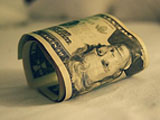Some Financial Definitions
29 Apr 2009
9 August 2007: the day that most experts agree the financial crisis began. French bank BNP Paribas suspended withdrawals from three of its funds, triggering a sharp rise in the cost of credit and a shock to investor confidence.
Credit crunch: a severe shortage of money or credit external pagehttp://news.bbc.co.uk/2/hi/business/7521250.stmcall_made
Credit default swap (CDS): a swap designed to transfer the credit exposure of fixed income products between parties. The buyer of a credit swap receives credit protection, whereas the seller of the swap guarantees the credit worthiness of the product. By doing this, the risk of default is transferred from the holder of the fixed income security to the seller of the swap. external pagehttp://www.investopedia.com/terms/c/creditdefaultswap.aspcall_made
CDS contracts have been compared with insurance because the buyer pays a premium and in return receives a sum of money if one of the specified events occurs. But there are a number of differences between CDS and insurance, e.g. the seller does not need to be a regulated entity and (in the US) CDS contracts are generally subject to market accounting, introducing income statement and balance sheet volatility that would not be present in an insurance contract. external pagehttp://en.wikipedia.org/wiki/Credit_default_swapcall_made
Collateralized debt obligations (CDOs): a type of asset-backed security and structured credit product involving a portfolio of fixed income assets rated at different levels of risk. They offered higher rates of return but greatly increased risk levels within the financial markets. This is because the loan originators retain no residual risk for the loans they make, but collect substantial fees on loan issuance, which causes unchecked degradation of underwriting standards. This problem was exacerbated by the failure of credit-rating agencies to take into account the collapse of underwriting standards when valuing these products. external pagehttp://en.wikipedia.org/wiki/Collateralized_Debt_Obligationscall_made
For a good multimedia presentation of CDOs see: external pagehttp://www.portfolio.com/interactive-features/2007/12/cdocall_made
Ninja loans: a type of sub-prime loan issued to borrowers with no income, no job and no assets.
Structured investment vehicle (SIV): invented by Citigroup in 1988, SIVs were a type of structured credit product. The strategy of these funds was to borrow money by issuing short-term securities at low interest and then lend that money by buying long-term securities at higher interest, making a profit for investors from the difference.
external pagehttp://en.wikipedia.org/wiki/Structured_investment_vehiclecall_made
For a more detailed explanation of SIVs see Standard & Poor's website: external pagehttp://www2.standardandpoors.com/portal/site/sp/en/us/page.article_print/2,1,1,0,1031342466642.htmlcall_made
Moral hazard: the prospect that a party insulated from risk may behave differently from the way it would behave if it were fully exposed to the risk. Moral hazard arises because an individual or institution does not bear the full consequences of its actions, and therefore has a tendency to act less carefully than it otherwise would, leaving another party to bear some responsibility for the consequences. In finance, moral hazard refers to financial bail-outs of lending institutions by governments, central banks or other institutions, if those that take the risks come to believe that they will not have to carry the full burden of losses. Essentially, profit is privatized while risk is socialized. Taxpayers, depositors and other creditors have often had to shoulder at least part of the burden of risky financial decisions made by lending institutions. external pagehttp://en.wikipedia.org/wiki/Moral_hazardcall_made
Panic of 1907: began with the demise of the Knickerbocker Trust, which failed when it financed a large-scale speculation in the stock market. Other New York trusts came under pressure with depositors queuing to withdraw funds. The result was that in two days a dozen trusts went under, credit markets froze, the stock market fell dramatically and confidence evaporated. The consequences for the real economy were severe: Unemployment increased from 3 to 8 percent, production fell by 11 percent and a four year recession ensued.
Securitization: a structured finance process that involves pooling and repackaging of cash-flow-producing financial assets into securities, which are then sold on to investors. If the transaction is properly structured and if the pool performs as expected, the credit risk of all tranches (portions or slices) of structured debt improves; if improperly structured, the affected tranches will experience dramatic credit deterioration and loss.
Systemic risk: the risk of collapse of an entire system or market and not to any one individual entity or component of that system. Systemic risk refers to the risks imposed by inter-linkages and interdependencies in a system or market if one player is eliminated, or a cluster of failures occur at once. external pagehttp://en.wikipedia.org/wiki/Systemic_riskcall_made
Trusts: bank-like institutions that emerged at the beginning of the 20th Century. Originally intended to manage only inheritances and estates for wealthy clients (low-risk activities), they were less regulated and had lower reserve requirements and lower cash reserves than national banks. As the economy boomed they increasingly began speculating in real estate and the stock market, offering depositors higher returns and taking a free ride on national banks' reputations for soundness.
Links and resources:Asia's sinking economies. The Economist, 29 January 2009.
DeGrauwe, Paul. The Banking Crisis: Causes, Consequences and Remedies. Centre for European Policy Studies, November 2008.
Discontents, wintry and otherwise. The Economist, 5 February 2009.
external pageThe Global Middle Classcall_made. Pew Research Center, 2 December 2009.
Kershaw,Chris, et. al. eds. Crime in England and Wales 2007/8. British Home Office Statistical Bulletin, July 2008.
Krugman, Paul. The Return of Depression Economics and the Crisis of 2008. New York, 2009. W. W. Norton & Company, Inc.
Loyn, David external pageDownturn ‘risks Africa conflict.’call_made BBC News, 16 March 2009.
The Middle Class in Emerging Markets. The Economist, 12 February 2009.
Palmer, Guy, et. al. external pageMonitoring Poverty and Social Exclusioncall_made, Joseph Rowntree Foundation, 8 December 2008
The Return of Economic Nationalism. The Economist, 5 February 2009.
external pageSpain’s Recession: After the Fiestacall_made. Financial Times, 7 February 2009.

